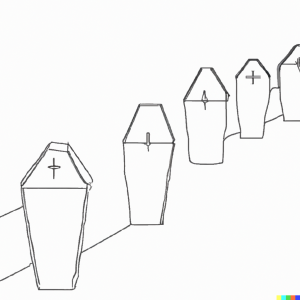Nav: The World
Geography | Biology | Civilization | Epidemic

So what do we know about the epidemic that devastated civilization on Hu?
- In the 1400s, an epidemic known as “the choke” emerged on Hu.
- The choke causes a hard ring to grow in the host’s windpipe, slowly strangling its victims over ten to twenty years.
- The disease is highly contagious and following its initial outbreak, it spread to all corners of the world, causing civilizations to collapse.
- The choke is a fungal infection, transmitted via spores, which can remain airborne for hours.
- The choke is a zoonotic disease, and is also carried by domesticated bonobos (in a far milder form).
- The disease progresses quicker in warm and wet climates, and slower in cold or dry climates.
- There is no known cure, but there are treatments that slow or reverse its progress.
- Newborn babies are immune to the choke for their first four weeks or so.
What are the symptoms?
- For the first year of infection there are no obvious symptoms apart from a sore throat.
- From the second year onwards, the host develops a hacking cough – expelling clouds of infectious spores
- Three or four years after infection, it becomes visible from the outside as a thickened ridge of bruised flesh that forms a collar-like band around the neck.
- After six to eight years, the host develops a constant wheeze.
- Towards the end, that wheeze turns into a droning whistle.
How have people learned to adapt?
Different cultures around the world have discovered different ways of dealing with the the epidemic over the last 500 years.
- Avoidance – stay away from infected people and keep to yourself!
- Segregation – organised avoidance, splitting regions into safe zones and wild zones.
- Facemasks – the disease is spread by coughing and breathing in spores, so wearing a facemask can reduce the risk of it spread.
- Filtration – an airtight helmet, with an air-supply drawn through a chemical filter mix which kills the spores.
- Early diagnosis – the disease is not infectious during the first year, but signs of its presence can be detected and the infected can be identified (and potentially banished).
- Newborn loophole – babies are immune for their first month, so sending a newborn from a wild zone to a safe zone means it can grow up with less chance of infection.
- Tracheotomy – cutting into a patient’s throat, and inserting a tube below the choke collar can allow them to keep breathing, but is risky in a world without antibiotics.
- Collar shaving – inserting a blade into a patient’s throat (like a sword swallower) and rotating it to shave the growth to undo some of the disease’s progress.
- Nebulized Potions – various acerbic concoctions, breathed in as a mist, which slow the growth or break it down (with associated side effects).
- Bonobo saliva – the disease jumped from domesticated bonobos to humans. In bonobos a compound in their saliva breaks down the choke’s growth, so it never progresses far enough to be life-threatening – they can cough up chunks. By harvesting bonobo saliva, people are able to treat the choke.